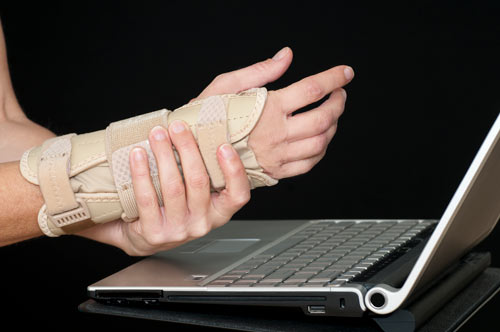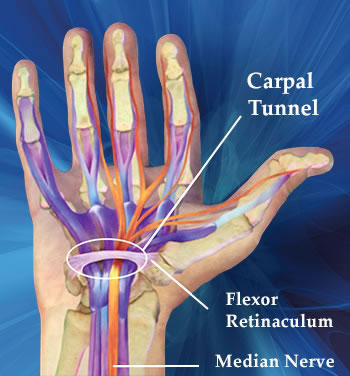Carpal Tunnel Syndrome is a painful condition affecting the wrists, hands, and arms. Initially, carpal tunnel syndrome may begin with numbness and/or tingling (pins and needles sensation known as paresthesia) then, as the condition worsens, paresthesia can escalate to severe pain along with loss of strength in the hands. Carpal tunnel syndrome commonly affects assembly line workers, data entry personnel, and grocery clerks. However, widespread usage of smartphones, computers, video games, and other electronic devices carpal tunnel syndrome is more prevalent.
Carpal tunnel syndrome often goes beyond dealing with pain. Carpal tunnel syndrome can affect your ability to work, get a good night’s sleep, and limit your ability to do the things you love. Ignoring carpal tunnel syndrome and hoping it will go away can create permanent nerve damage in your hands and wrists.
What Causes Carpal Tunnel Syndrome?
To better understand the cause of carpal tunnel syndrome, it is important to know how the bones and nerves in our wrists interact. The wrist starts at the distal ends of our forearm bones (radius and ulna) and contains eight (8) carpal bones. The carpal bones join to the proximal portions of the five (5) metacarpal bones (long finger bones) in our hands. The carpal bones form the shape of a protective tunnel that allows nerves to pass through to our hands. These nerves are held in place by the flexor retinaculum (anterior annular ligament), acting like a zip-tie, keeping our nerves protected and secured inside the carpal tunnel.
The Median Nerve is the main nerve controlling our hands. The nerve roots exiting our spine at the neck (C6, C7, C8) and upper thoracic area (T1) form the median nerve. The median nerve then passes through our shoulder, down our arm, through the carpal tunnel to the hand, and controls the thumb and index finger, along with parts of the middle and ring fingers.
Carpal tunnel syndrome occurs when there is irritation to the median nerve, such as being compressed or pinched.
Here are some causes of carpal tunnel syndrome.
- Misalignment of the bones forming the carpal tunnel. This results in the tunnel “collapsing” and putting pressure on the nerves, creating inflammation and pain.
- Pressure directly on the median nerve for extended periods.
- The inflammation and swelling associated with rheumatoid and osteoarthritis can narrow the carpal tunnel opening and irritate the nerve.
- Fractures or injuries to the wrist and hand.
- Repetitive strain injury to the hands and wrists.
- Poorly set up work environment, forcing your wrist to be in an awkward position for an extended period.
How to Prevent Carpal Tunnel Syndrome
Proper posture is key to avoiding carpal tunnel syndrome.
The greater the pressure placed on your wrists, the greater the chance you will get carpal tunnel syndrome. Pay attention to your posture at work. Are you leaning forward and putting weight on your wrists? Is your keyboard too close to your body causing you to bend your wrists to type? Is your keyboard positioned in a way that requires your wrists to bear weight? As you sit at your desk, which part of your arm is resting on your desk — your forearm or your wrist?
Here are some tips you can use for better posture:
- Sit up straight with your shoulders over your hips, not in front of your hips.
- When your shoulders and head move forward, weight transfers from your hips to your arms and wrists. Allowing your shoulders to slump forward, or sitting with your head forward of your shoulders, can stretch and damage the median nerve which passes through your shoulders.
- Keep your keyboard far enough in front of you allowing your forearms to rest on the desk, not your wrists.
- Avoid low, pullout keyboards that place your wrists at an awkward angle and put pressure on the median nerve.
- Take breaks and stand up for 5 minutes every 30-60 minutes.
View our article on proper posture.
Repetitive work and tasks, whether at the computer or on an assembly line, are a leading cause of carpal tunnel syndrome. To be proactive, you should regularly do exercises that use your hand muscles differently. Squeezing a rubber ball or tennis ball 10 to 15 times will provide stress relief to your hands and improve your grip strength. Doing wrist and finger rehabilitative extension exercises will help to strengthen and stabilize your wrist.
Dealing with Carpal Tunnel Syndrome
Carpal Tunnel wrist splintCarpal tunnel syndrome is not something you just ignore and hope will get better on its own. Carpal tunnel syndrome is nerve damage, and it can continue to get worse until you end up needing to have surgery. For most people, Carpal tunnel syndrome can be treated with chiropractic care, rehabilitative extension exercises, and a properly setup work station. It is possible to become pain-free and be able to throw that wrist brace away.

Chiropractic Care and Carpal Tunnel Syndrome
Too often, people suffering from carpal tunnel syndrome turn to treatments that don’t correct the cause of their pain. Using pain medications, wearing wrist splints, or even considering surgery — none of these choices deal with the source of your problem. Taking pain meds to cover up the pain can allow more damage to occur. A wrist splint brace, which attempts to reduce inflammation in the wrist by restricting movement, ends up making your muscles weaker and more susceptible to recurring carpal tunnel syndrome. And surgery should always be viewed as the last resort. In addition to the expense of surgery, carpal tunnel surgery can end up doing lasting damage to the wrist and require substantial rehab time.
Chiropractic care for carpal tunnel syndrome takes a different approach. Chiropractic care will focus on finding the cause of pressure and inflammation to the median nerve and correcting it. Chiropractic care uses specific adjustments to restore the joints in the wrist to their proper position and restore motion. Tuckahoe Family Chiropractic will provide specific suggestions to enhance your work environment, reducing the chance of reoccuring carpal tunnel syndrome. As part of your treatment, Tuckahoe Family Chiropractic will recommend rehabilitative exercises and stretches to restore function and movements, reduce inflammation, and ease your pain.
Chiropractic care has produced excellent results for patients experiencing carpal tunnel syndrome — without resorting to pain medications or surgery.
Call Tuckahoe Family Chiropractic at 804.740.3434 to arrange a consultation. Carpal tunnel syndrome can be treated and corrected. If any of your friends and family can benefit from this article on carpal tunnel syndrome, please recommend this article to them.

